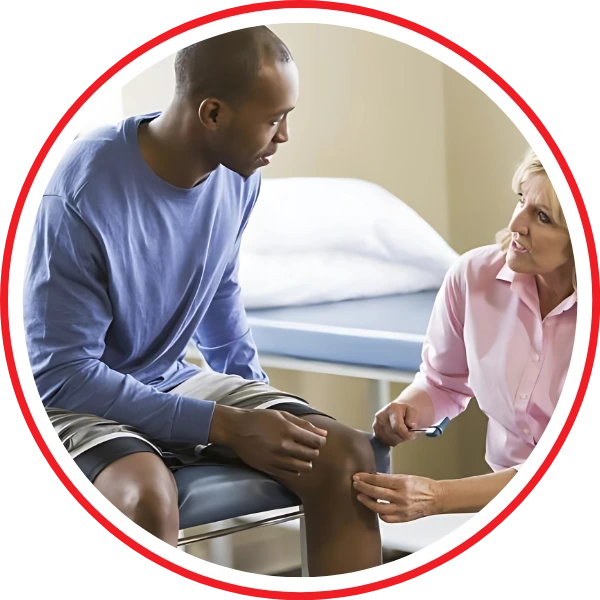
The Anterior Cruciate Ligament (ACL) is one of the key ligaments that stabilize the knee joint. It connects the thigh bone (femur) to the shinbone (tibia) and plays a vital role in enabling smooth, stable movement during activities such as running, jumping, and turning.
ACL injuries are common in sports and high-impact activities but can also occur due to accidents, sudden stops, or awkward landings. A torn ACL cannot heal on its own, and in many cases, ACL Reconstruction Surgery is recommended to restore knee function, prevent further injury, and enable a return to normal or athletic activity.
Surgery may be advised if:


While generally safe, ACL reconstruction carries some potential risks:
Choosing a highly experienced orthopedic surgeon and following a structured rehab plan significantly reduces these risks.
Some advanced orthopedic programs include:
ACL Reconstruction Surgery is a proven solution for restoring knee strength, stability, and mobility after ligament injury. With minimally invasive techniques, advanced graft options, structured post-op rehabilitation, and personalized follow-up care, patients can confidently return to their active lifestyles.
Early diagnosis, expert surgical intervention, and dedication to rehabilitation are the keys to achieving the best possible outcome.


Head of the Department, Joint Replacement, Sports & Spine Orthopedic Surgeon
CONSULTS ATIndraprastha Apollo Hospital, Delhi
EXPEREIENCE :Head of the Department, Joint Replacement, Sports & Spine Orthopedic Surgeon
CONSULTS ATIndraprastha Apollo Hospital, Delhi
Director of Orthopedics Department, Joint Replacement Surgeon
CONSULTS ATFortis Flt. Lt. Rajan Dhall Hospital, Vasant Kunj
EXPEREIENCE :Director of Orthopedics Department, Joint Replacement Surgeon
CONSULTS ATFortis Flt. Lt. Rajan Dhall Hospital, Vasant Kunj
Director Orthopedics & Joint Replacement, Spine Surgery
CONSULTS ATMax Hospital, Saket
EXPEREIENCE :Director Orthopedics & Joint Replacement, Spine Surgery
CONSULTS ATMax Hospital, Saket
Director Orthopedics Department, Joint Replacement and Spine Surgery
CONSULTS ATFortis Flt. Lt. Rajan Dhall Hospital, Vasant Kunj
EXPEREIENCE :Director Orthopedics Department, Joint Replacement and Spine Surgery
CONSULTS ATFortis Flt. Lt. Rajan Dhall Hospital, Vasant Kunj

![]() Sector 51, Gurugram, India
Sector 51, Gurugram, India
Artemis is the first JCI and NABH accredited multi-specialty hospital in Gurgaon.
![]() Rajendra Place, New Delhi, India
Rajendra Place, New Delhi, India
One of Asia's largest Bone Marrow Transplant center with 1500 healthcare providers
![]() Vasant Kunj, Delhi
Vasant Kunj, Delhi
NABH accredited hospital, NABL accredited LAB, NABH accredited blood bank, Green OT certification
![]() Noida, India
Noida, India
World class facility with over 200 beds and 7 operational theaters. Most trusted Kidney & Liver Transplant.
ACL reconstruction is a surgical procedure to replace a torn anterior cruciate ligament in the knee using a tissue graft. It helps restore stability, mobility, and strength to the knee joint.
Surgery is usually recommended for people with a completely torn ACL, especially if they are athletes, physically active, or experience knee instability during daily activities.
It is typically done arthroscopically (minimally invasive). The surgeon removes the torn ligament and replaces it with a graft taken from the patient’s own tendon (autograft) or a donor (allograft).
The surgery usually takes 1–2 hours. Most patients go home the same day after the procedure.
Full recovery may take 6–9 months. Patients usually begin walking with support within a few days and gradually return to sports or strenuous activity after rehabilitation.
Possible risks include infection, stiffness, blood clots, graft failure, or knee pain. With modern techniques and skilled surgeons, complications are rare.
Yes. A structured physiotherapy program is essential to restore flexibility, build muscle strength, and regain knee function after ACL reconstruction.
Partial ACL tears may heal with rest and physiotherapy. However, complete tears usually require surgery for proper stability, especially for active individuals.
Most patients return to sports between 6–12 months after surgery, depending on healing, rehab progress, and muscle strength recovery.
ACL reconstruction has a high success rate of restoring knee stability and function. With proper rehab and lifestyle care, most patients return to their normal activity levels.